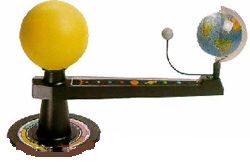BACKGROUND:
Our Solar System has a central Sun, around which
revolve the nine planets and countless small objects. As a unit the Solar
System revolves amongst the stars of the Milky Way, slowly circling the core
of the galaxy.
There are numerous differences between the Sun and the
planets. These include:
- radiation vs. reflection
- The Sun creates its own energy; we see this energy radiating as light.
The planets only reflect the light created by the sun
- size - The Sun is by far the largest body
in the Solar System, with a diameter of 1.4 x 1016
kilometers - that is 14 followed by fifteen zeros! Jupiter is the
largest planet, with a diameter of 142980 kilometers. The Earth’s
diameter is 12756 kilometers.
- composition - the
Sun is largely composed of gaseous hydrogen and helium, with small
amounts of other elements. The planets have a wide variety of
compositions. Jupiter , Saturn, Uranus, and Neptune are similar to the
Sun, but contain more carbon compounds such as methane, and small
amounts of rock. The inner planets - Mars, Earth, Venus, and Mercury,
are composed mostly of rock and metal, with thin gaseous atmospheres.
The composition of Pluto is uncertain.
- temperature - the
Sun is very hot; its surface temperature is about 6000 K (degrees
Kelvin). The planets are much cooler. Venus has the hottest planetary
surface temperature, about 750K, while Pluto likely has the coldest, at
about 50 K.
PROCEDURE:
- Explain to the students that our Sun and its planets are called the
Solar System. Tell them that the Solar System is part of a larger
grouping of stars, called a galaxy. Our galaxy is called the Milky Way;
this is where the name of the candy bar came from. Emphasize to the
students that the Solar System and the Milky Way are only a small part
of the Universe. Go over the different planets of the Solar System. Draw
a picture as below to show the planets orbit. Notice that the
planets revolve around the Sun in a well defined zone. The planets do
not revolve in any direction.

 Use the
Planetarium to show students the movement of the Earth and Sun. The Sun
also shows how it generates light. Only stars produce light; all other
bodies in the Universe only reflect starlight. Use the
Planetarium to show students the movement of the Earth and Sun. The Sun
also shows how it generates light. Only stars produce light; all other
bodies in the Universe only reflect starlight.
- Have the students complete the worksheet. First, have them list the
differences between a star and a planet. You can have them work
individually, or go over the answers as a group.
Next, have the students color the worksheet, using colors which
accurately portray the Sun and Earth. The Sun can be yellow to orange.
The Earth can be white (clouds), blue (ocean), and brown or green
(continents).
- Read the book Is there Life in Outer Space to the class. This
will familiarize the students with the different components of the Solar
System. Do not have them memorize information about the planets.
Instead, let them slowly digest the information.
Information on the planets increases every year. Not only is the
United States exploring space, but many other countries are
investigating the planets of our Solar System. Books that have been
published in the past may contain erroneous or out-of-date information
because of this new research. However, these books may still be useful
for their ability to reach younger children, as long as you correct
their mistakes.
|